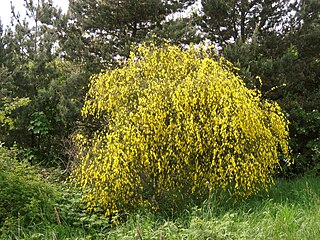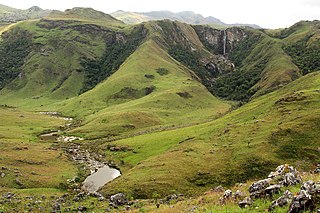
A shrub is a small-to-medium-sized perennial woody plant. Unlike herbaceous plants, shrubs have persistent woody stems above the ground. Shrubs can be either deciduous or evergreen. They are distinguished from trees by their multiple stems and shorter height, less than 6–10 m (20–33 ft) tall. Small shrubs, less than 2 m (6.6 ft) tall are sometimes termed as subshrubs. Many botanical groups have species that are shrubs, and others that are trees and herbaceous plants instead.

Buxus is a genus of about seventy species in the family Buxaceae. Common names include box or boxwood.

Mount Cameroon is an active volcano in the South West region of Cameroon next to the city of Buea near the Gulf of Guinea. Mount Cameroon is also known as Cameroon Mountain or Fako or by its indigenous name Mongo ma Ndemi. It is the highest point in sub-Saharan western and central Africa, the fourth-most prominent peak in Africa, and the 31st-most prominent in the world. The mountain is part of the area of volcanic activity known as the Cameroon Volcanic Line, which also includes Lake Nyos, the site of a disaster in 1986. The most recent eruption occurred on February 3, 2012.

The Madagascar subhumid forests are a tropical moist broadleaf forest ecoregion that covers most of the Central Highlands of the island of Madagascar. They are included in the WWF's Global 200 list of outstanding ecoregions. Most of the original habitats have been lost due to human pressure.

The Galápagos Islands xeric scrub, also known as the Galápagos Islands scrubland mosaic, is a terrestrial deserts and xeric shrublands ecoregion that covers the Galápagos Islands. The Galápagos Islands are volcanic in origin, and remote from continents and other islands. The ecoregion is well known for its unique endemic species, including giant tortoises, birds, and marine iguanas, which evolved in isolation to adapt to islands' environments.

Shrubland, scrubland, scrub, brush, or bush is a plant community characterized by vegetation dominated by shrubs, often also including grasses, herbs, and geophytes. Shrubland may either occur naturally or be the result of human activity. It may be the mature vegetation type in a particular region and remain stable over time, or a transitional community that occurs temporarily as the result of a disturbance, such as fire. A stable state may be maintained by regular natural disturbance such as fire or browsing. Shrubland may be unsuitable for human habitation because of the danger of fire. The term was coined in 1903.

Buxus sempervirens, the common box, European box, or boxwood, is a species of flowering plant in the genus Buxus, native to western and southern Europe, northwest Africa, and southwest Asia, from southern England south to northern Morocco, and east through the northern Mediterranean region to Turkey. Buxus colchica of western Caucasus and B. hyrcana of northern Iran and eastern Caucasus are commonly treated as synonyms of B. sempervirens.
Podocarpus madagascariensis is a species of conifer in the family Podocarpaceae. It is found only in Madagascar.
Pistacia aethiopica is an African and Arabia coast peninsula species of plant in the family Anacardiaceae. It is a dioecious evergreen shrub or tree of the pistacio genus, growing up to 20 m (66 ft) tall, adapted to the dry environment. It is found in Ethiopia, Kenya, Somalia, Somaliland, Tanzania, Uganda, and Yemen.

The Socotra Island xeric shrublands is a terrestrial ecoregion that covers the large island of Socotra and several smaller islands that constitute the Socotra Archipelago. The archipelago is the western Indian Ocean, east of the Horn of Africa and south of the Arabian Peninsula. Politically the archipelago is part of Yemen, and lies south of the Yemeni mainland.

The Cuban dry forests are a tropical dry forest ecoregion that occupies 65,800 km2 (25,400 sq mi) on Cuba and Isla de la Juventud. The ecoregion receives 1,000–2,000 mm (39–79 in) of rainfall annually. Cuban dry forests can be differentiated into evergreen forests, semi-deciduous forests, mogotes, and sclerophyllous low forests.

The Ethiopian xeric grasslands and shrublands ecoregion is a semi-desert strip on or near the Red Sea and the Gulf of Aden coasts in Eritrea, Ethiopia, Djibouti and Somaliland. This ecoregion lies mainly between sea level and 800 meters (m) elevation. There are, however, many hills and massifs, which range up to 1300 m as well as outstanding fault-induced depressions, such as the Danakil, lying as low as 155 m below sea level. This region is extremely active tectonically, experiencing many earthquakes and intermittently active volcanoes. Rainfall is very low and yearly averages range from 100 to 200 millimeters (mm), with less rain falling closer to the coast. There are many species of interest, including the endemic Archer's lark, a species of dragon tree, and a large suite of desert ungulates, including the last viable population of African wild ass.

The Hobyo grasslands and shrublands is a desert and xeric scrubland ecoregion in Somalia. The ecoregion includes a belt of coastal dunes, 10 to 15 km wide, along the Indian Ocean coast, extending from north of Hobyo to south of Mogadishu.

The Chimanimani Mountains are a mountain range on the border of Zimbabwe and Mozambique. The mountains are in the southern portion of the Eastern Highlands, or Manica Highlands, a belt of highlands that extend north and south along the international border, between the Zambezi and Save rivers.

Gaanlibah or Ga'an Libah is mountain range, archaeological site, and national park located in the Maroodi Jeex region of Somaliland. Nearby are the Golis Mountains. Its upper slopes are the source of the seasonal Togdheer river that flows through the city of Burao into the Nugaal Valley.

The Somali montane xeric shrublands is a desert and xeric scrubland ecoregion in Somalia. The ecoregion lies in the rugged Karkaar Mountains, which run parallel and close to Somalia's northern coast on the Gulf of Aden, and follows coast from Cape Guardafui south to Eyl on the Arabian Sea.

The Southwestern Arabian foothills savanna, also known as the Southwestern Arabian Escarpment shrublands and woodlands, is a desert and xeric shrubland ecoregion of the southern Arabian Peninsula, covering portions of Saudi Arabia, Yemen, and Oman.

The Mediterranean High Atlas juniper steppe is a montane grasslands and shrublands ecoregion in Morocco. It extends along the High Atlas range of northwestern Africa's Atlas Mountains.
Erica trimera is a species of flowering plant. It is a shrub or tree which grows in the mountains of eastern and central Africa.

Cassipourea malosana is a species of plant native to tropical Africa.















